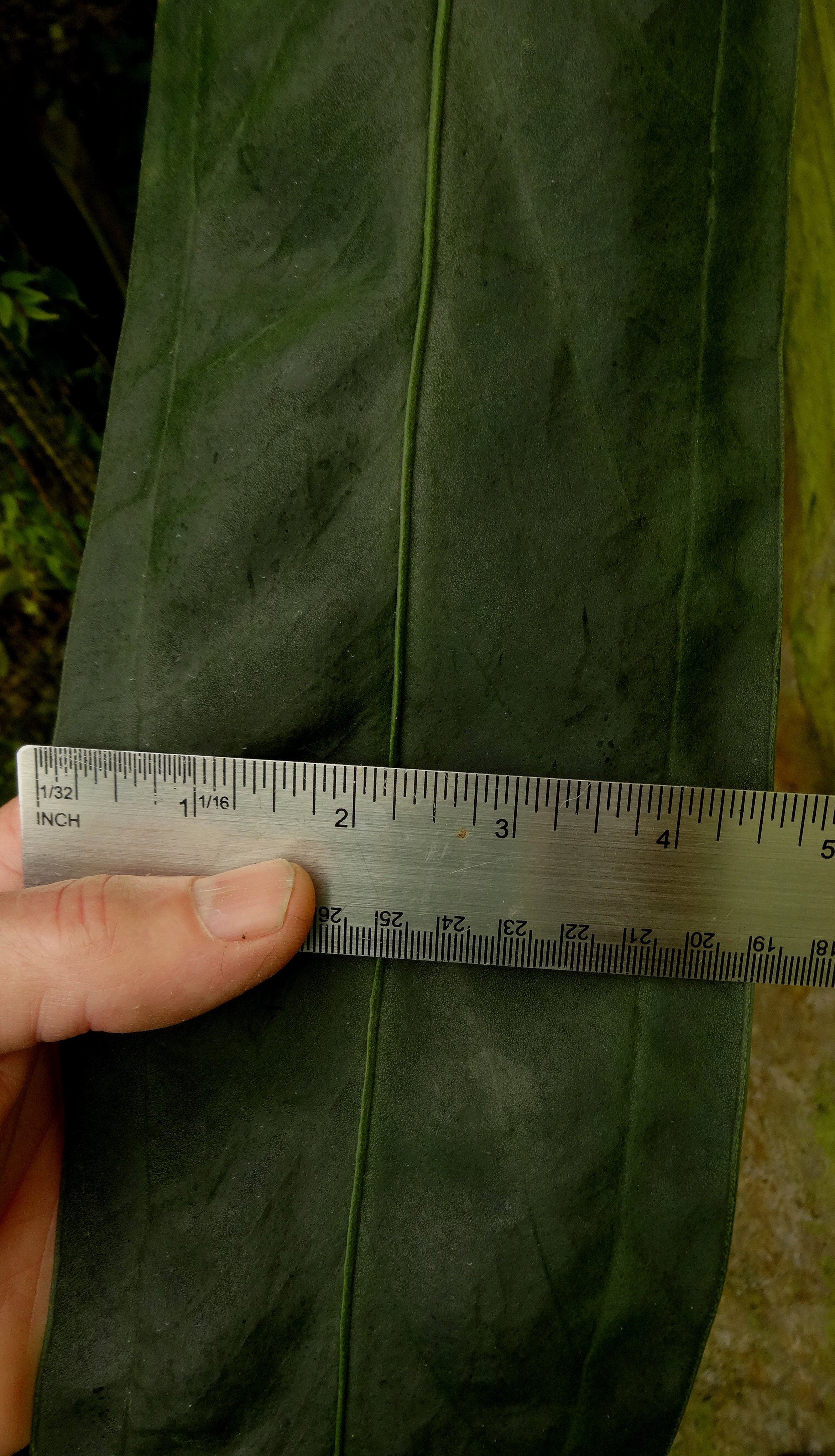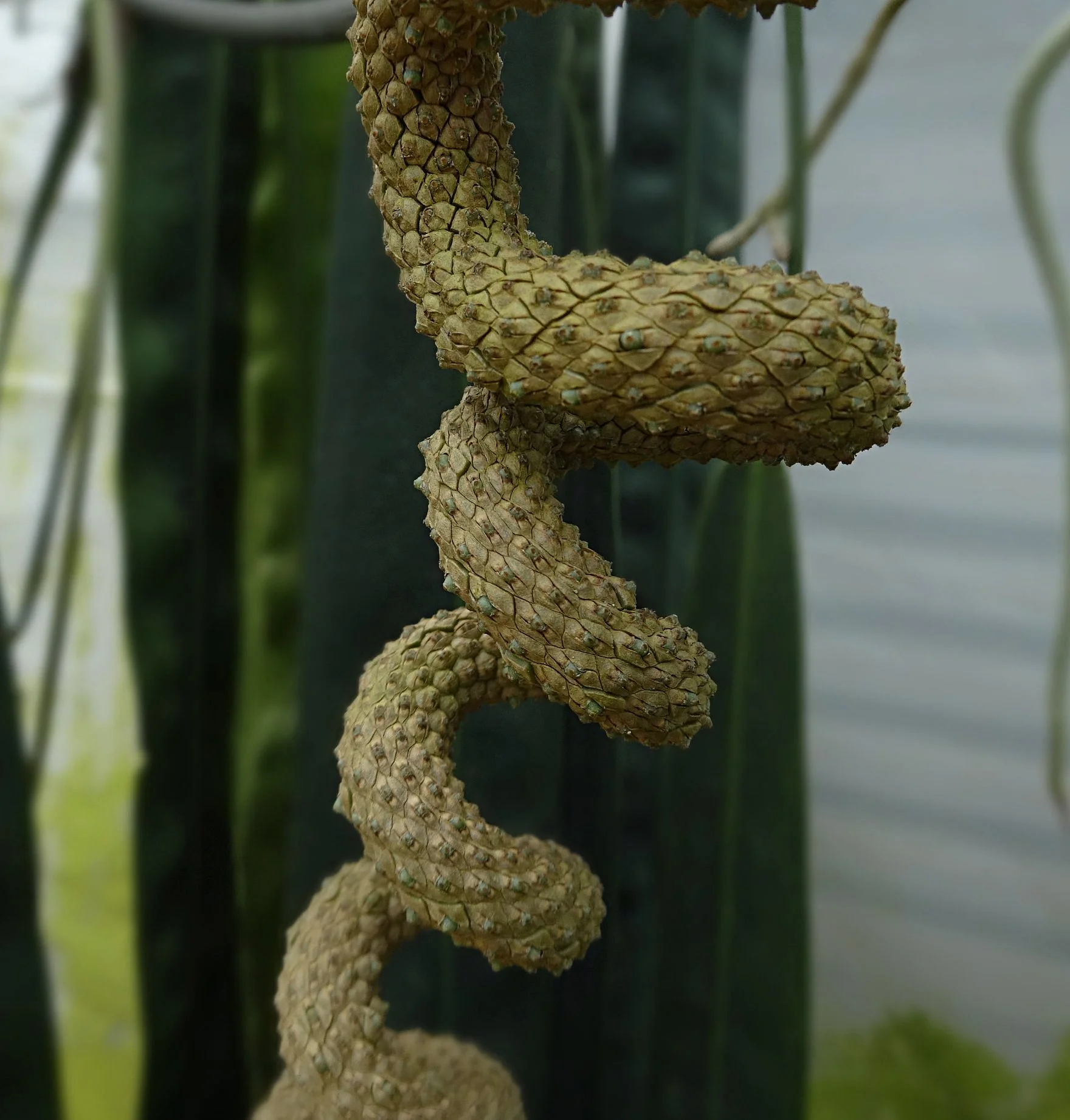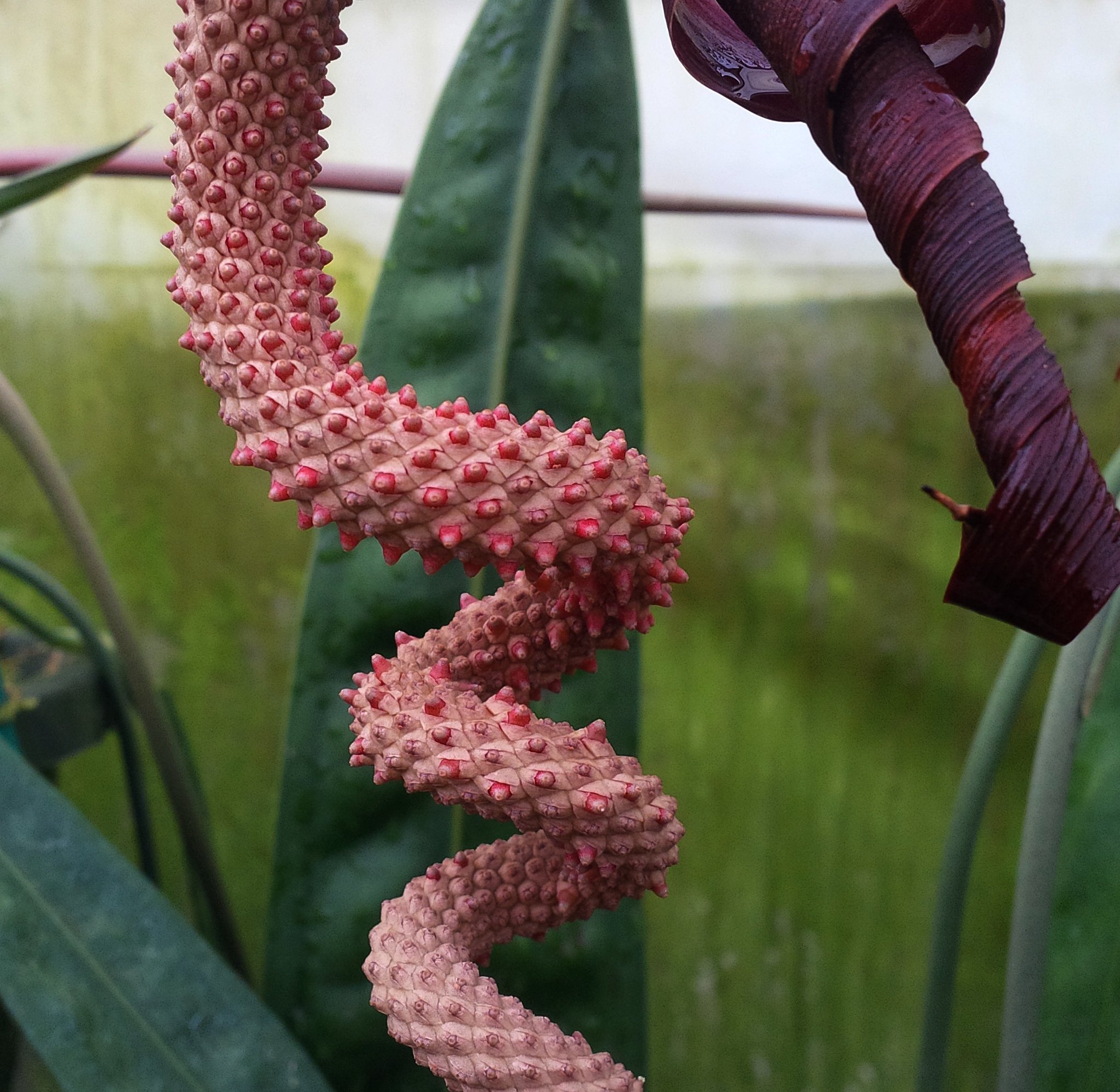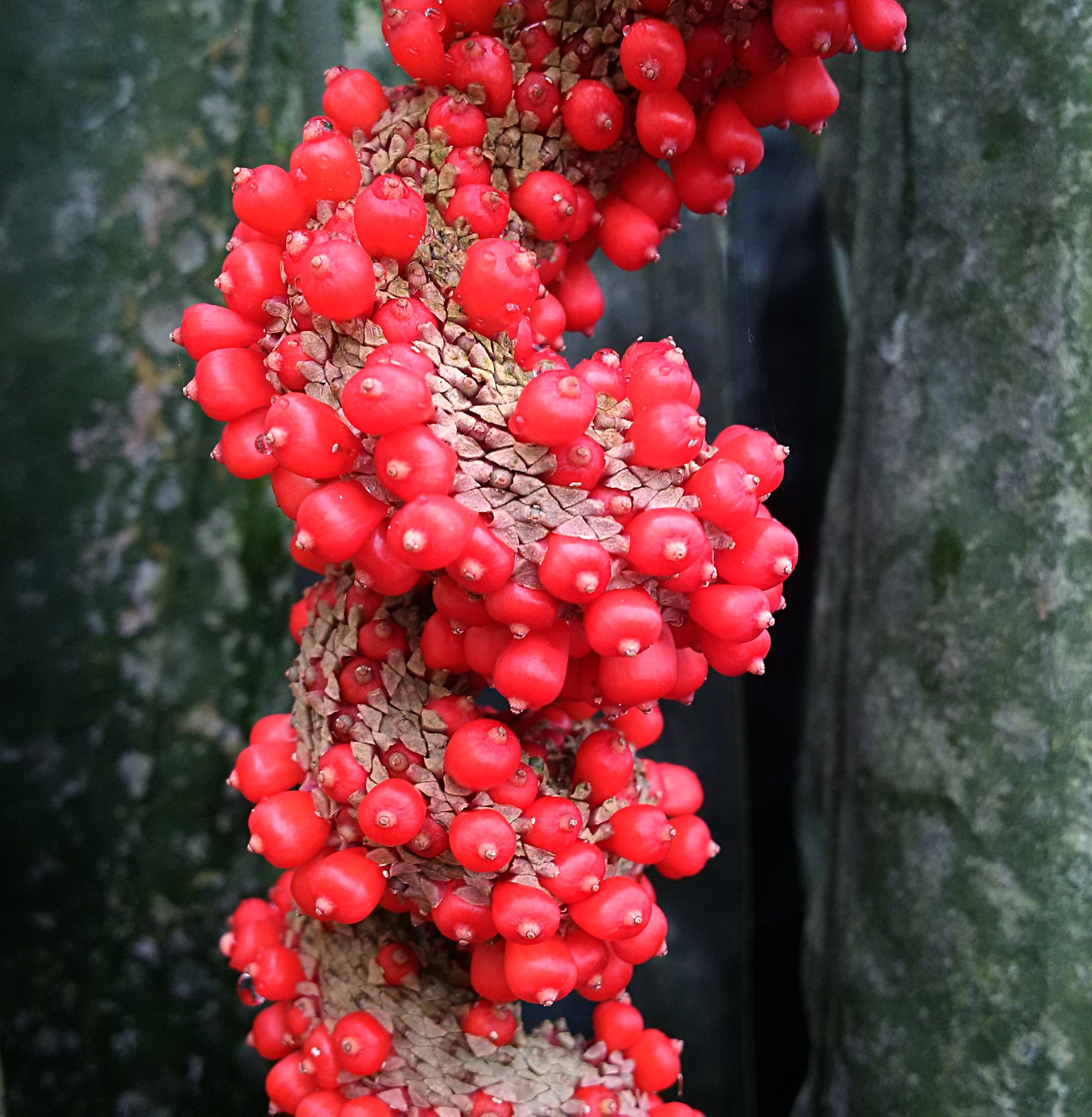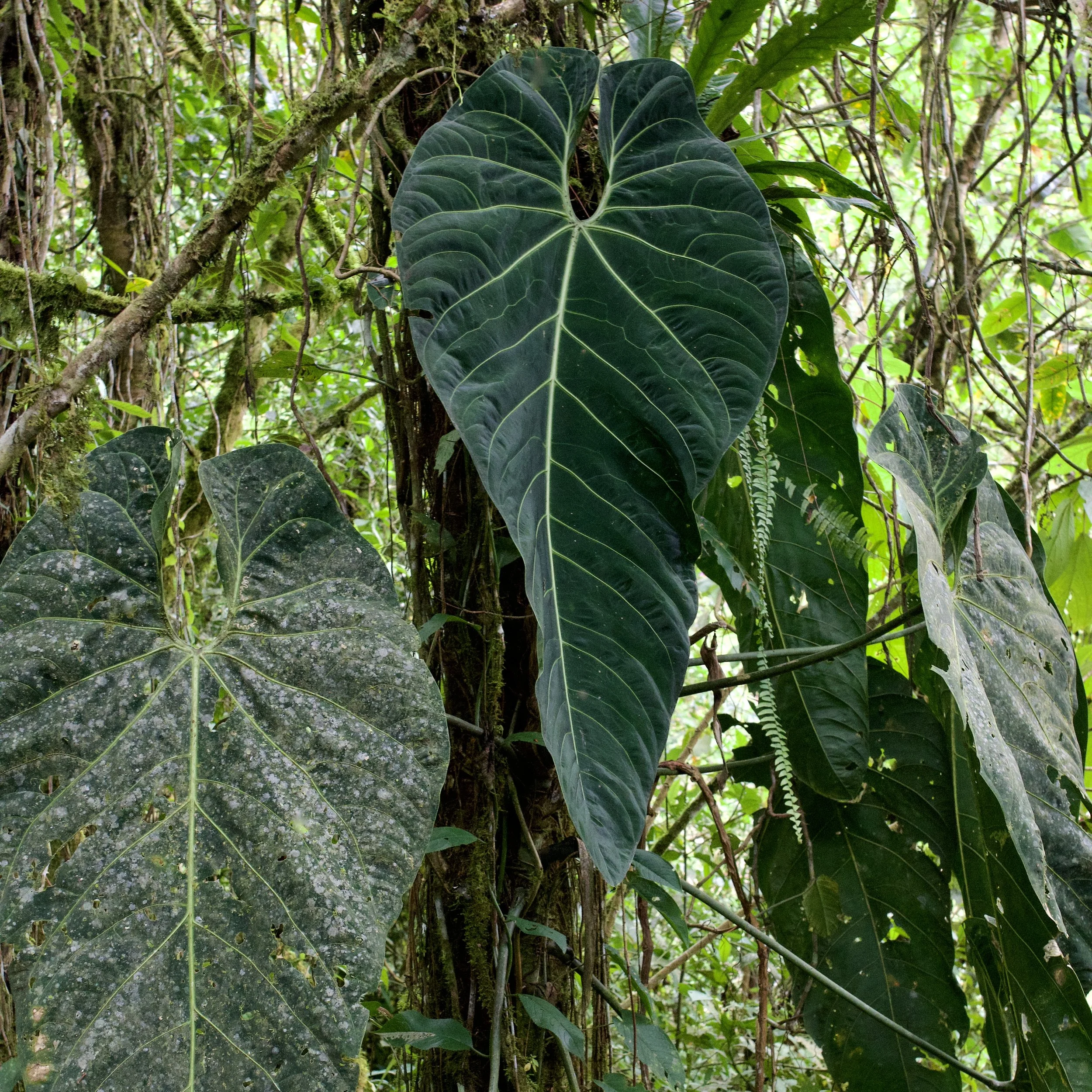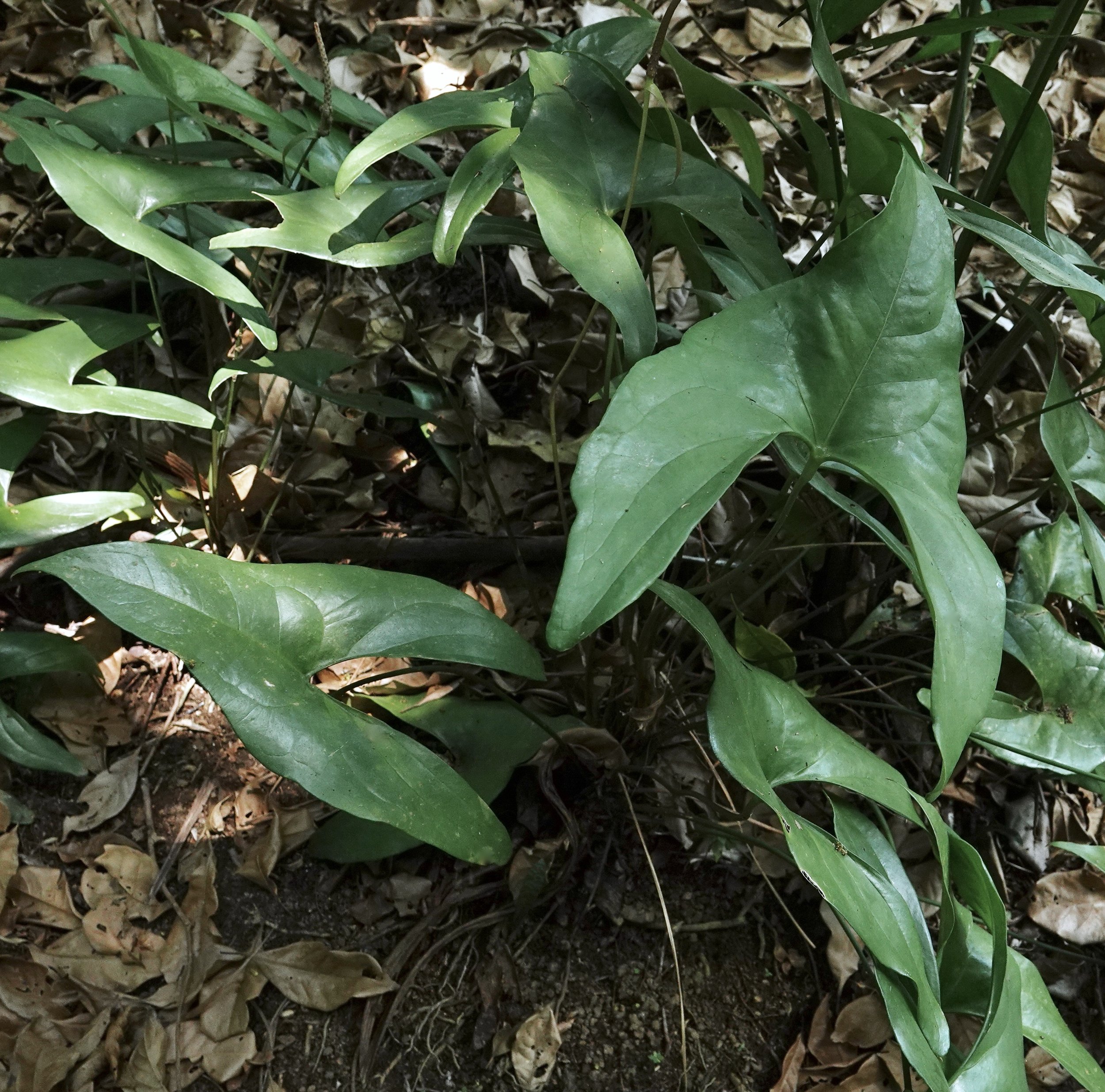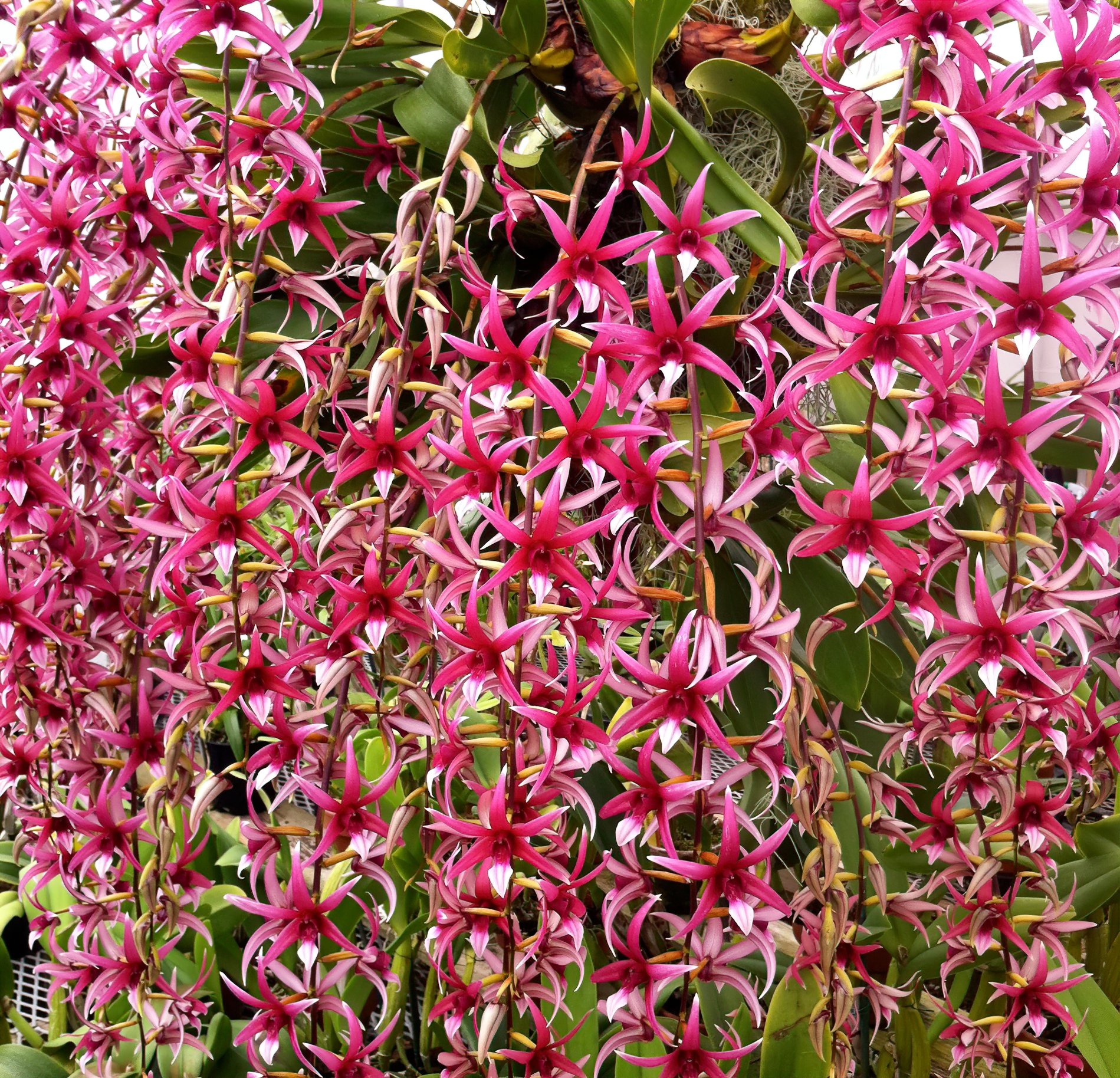Anthurium wendlingeri - velvet leaf, pendent Panamanian prize
by Jay Vannini
Noteworthy among the many striking tropical aroids in cultivation a mature, a well-grown Anthurium wendlingeri is a definite standout in any collection. This imposing and showy epiphytic anthurium species was described in 1965 based on a living plant originating from near Turrialba, Cartago Province, Costa Rica. It appears to have been quite rare in cultivation for the next 20 plus years. An article published in 1978 by researchers at the University of Hawaii at Manoa confirm that they were growing and hybridizing it in the early 1970s, and TROPICOS records show the Missouri Botanical Gardens had at least one flowering-sized specimen in their collection in 1986 (see Croat #61144). While still comparatively uncommon in ornamental horticulture when compared with other Anthurium species popular with hobbyist growers, over the past decade it has become more available to specialist private collectors in the U.S., Australia and southeast Asia. Images online indicate that it is also well-represented in a number of public gardens in the EU.
A young, variegated second generation seed-grown Anthurium wendlingeri in the author’s collection. This individual flushes very high contrast and attractive albovariegated leaves that fade slowly to marbled dark green immediately prior to each new leaf flush.
Anthurium wendlingeri has a relatively wide - although discontinuous - distribution in tropical rainforests from the Río San Juan Department of SE Nicaragua through the length of Costa Rica and Panamá on both slopes (although generally more prevalent on the Caribbean side), through the Guna Yala Comarca to the border region just into western Colombia in the Chocó Department. Likewise, it has a fairly large elevational range from near sea level to over 4,700'/1,450 masl, although it is usually a lowland plant. My observations and catalogued collections indicate that it appears to be most abundant in lowland and premontane rainforests between approximately 300-2,600'/100-800 masl. There can be marked size variation among local ecotypes throughout its range. The largest plants that I have encountered in nature were growing in upland rainforests of Veraguas, Chiriquí and Bocas del Toro provinces in western Panamá. Wild plants may be observed in this region with leaves exceeding 4'/1.20 m in length. In my experience, plants from lowland tropical rainforest in NE Costa Rica and the Guna Yala (formerly San Blas) region of eastern Panamá tend to be rather small. I have seen leafy, apparently fully mature flowering plants on both the Llano-Cartí Road and near Lago Bayano in Panamá Province that had leaves that were only 24"/60 cm in length. A short-leaf, clustering clone that is now in wide distribution in the U.S. was collected in El Valle de Antón, Coclé Province, Panamá in 1982 by a good friend in California. Several San Francisco area orchid nurseries, as well as the SF Conservatory of Flowers showcase this plant. Often thinly distributed, they can be a very conspicuous component of subcanopy epiphyte communities in mature forest such as that on the foothills of Cerro Tute-Mariposa, Veraguas Province, Panamá.
Three founding stock plants flanking my front door in Guatemala in 2009. Fortuna, Panamá seed parent ('TRex') flowering to the left, southeastern Costa Rican pollen parents from Selby BG flowering to the right, together with an solitary A. vittarifolium. From this trio of original wild-collected plants, more than a thousand F1 and F2 seedlings have been distributed around the world to date.
A young example of a nice, long leaf form of Anthurium wendlingeri in nature, Limón Province, Costa Rica.
I began to grow this species at my home in Guatemala in early 2000 when I was fortunate to acquire two young plants from the late Harry Luther, then at the Marie Selby Botanical Gardens. These plants purportedly originated from collections made several years earlier in both Limón and in Puntarenas Provinces, Costa Rica. Both accessions are of the long and wide leaf form. In early 2001 I picked up a tiny seedling taken off an overgrown road cut along the highway to the town of Almirante in Bocas del Toro Province, Panamá. While originally mistaken for an immature A. pseudospectabile, it became apparent after six months in cultivation that it was an exceptionally robust example of A. wendlingeri. By early 2004, all three plants began flowering in synchrony and I began a propagation program that continues through present day using the particularly showy Panamanian plant as the original seed parent. Over the past years I have produced relatively large numbers of artificially-propagated plants of this species into second generation in both Guatemala and California, and have distributed seed and plants to other plant collectors in a number of countries. Due to sale of my seed-grown plants through a well-known retail orchid nursery in Guatemala City, they have become a very popular greenhouse and atrium subject among advanced orchid growers both in Guatemala and El Salvador.
A collection of eight year-old, flowering-sized F1 Anthurium wendlingeri grown in 8"/30 cm hanging plastic pots in a private collection at Orquídeas S y M in Guatemala City, Guatemala. These are offspring of plants shown above and siblings of my stock plants in California. Note exceptional leaf form of middle plant.
Two developing spadices on a mature Anthurium wendlingeri in cultivation in California.
Its closest relative appears to be A. pendens, a smaller species which occurs in sympatry with A. wendlingeri at several localities I am familiar with, particularly in coastal and foothill areas of eastern Colón Province in central Panamá. They are easily distinguished in the field by the differing basal shapes of their leaves (acute versus round-truncate, respectively), the shape of the leaf blades themselves, and in flower by the distinctive long, corkscrewed spadix in A.wendlingeri when compared to the relatively short, slightly curved spadix in A. pendens. Anthurium pendens also tends to have leaves that are visibly broader below the middle of the blade and are usually shorter, narrower, matte-texture and markedly greener than those of A. wendlingeri.
A variety with straight spadices at anthesis was described from a cultivated plant collected near Guápiles in Limón Province, Costa Rica by Thomas Croat in 2022 as var. horichii. Other plants with straight spadices have been found in nature on the Caribbean slope of Costa Rica by an amphibian researcher (Croat, per. comm.).
While the elegant plant form and long, rippled, blackish-green leaf blades enhanced by a glittering, velvety texture on the upper surface are the principal attractions of this species, it is their conspicuously quirky, inflorescences that prompt the most comments from observers. Emerging rapidly from a wrapping of an elongated spathe, the spadix begins to coil midway in its development, terminating with a long (to over 30"/75 cm), simple or reverse corkscrew shape. The inflorescences are relatively long-lasting, and a fully-pollinated infructescence studded with hundreds of small, bright red fruit is a very attractive sight.
Mature Anthurium pendens from lowlands of Colón Province, Panamá in cultivation in California.
Inflorescence on mature Anthurium pendens in cultivation in California
I have grown this species in basket culture in a wide variety of media, ranging from shredded tree fern fiber and charcoal chips, traditional orchid bark-based mixes, etc. through to pure New Zealand long fiber sphagnum. I now favor an open, long-lasting mix that permits multiple transplants contemplated into the future without requiring too much disturbance to the roots. Currently, most of my founder stock in California is being grown in a traditional bark+charcoal+perlite mix or equal parts expanded clay spheres (LECA), shredded tree fern fiber, and knife-cut coconut fiber croutons. To this mix I add small amounts of slow release encapsulated gypsum and dolomite, and a generous application of balanced NPK formula six or nine month time release Nutricote. These plants are fairly heavy feeders when well-cultivated, and new leaves should always be at least as long as the prior leaf. Barring indications of leaf loss, any “shrinkage” on new growth indicates that heavier feeding is indicated. As is the case in many Anthurium species, large, well-established specimens resent losing their main roots to rough handling, so careful and infrequent potting on is always a better option to annual repotting. Future root space requirements should be taken into account when deciding on a suitable growing medium and pot or basket size. They respond well to warm daytime temperatures (85 F/~30 degrees C) and frequent watering. In an atrium in Guatemala, this species has shown remarkable cool temperature tolerance to brief overnight lows in the 40 F/4 C range. My greenhoused plants in San Francisco, California are occasionally exposed to lengthy overnight lows in the 48 F/9 degree C range during the winter months. They despise windy conditions when grown outdoors and excessive air movement when under glass.
Four and one-half foot /1.40 m newly hardened leaf of one of my F1 Anthurium wendlingeri greenhoused in California.
Ultimate leaf size and width in this species appears to be genetically hard-wired, and the smaller ecotypes will never achieve the imposing dimensions that some exceptional plants from the middle parts of the species’ range achieve. I have selectively bred my stock specifically to produce plants with long, wide, rippled and very dark-colored leaf lamina that carry large numbers of leaves and are free-flowering in maturity. The largest leaves that I have produced on my oldest plants in Guatemala are 5.5'/1.70 m long x 5"/13 cm wide. I have achieved the same width but about 6"/15 cm shorter leaf lengths in California. I have little doubt that under optimal conditions grown as very warm tropicals under high relative humidity and plenty of shade, exceptional examples of this species are capable of producing leaf lamina approaching over 6'/1.85 m in length and >7"/17.5 cm wide. There are some local variants from Costa Rica and Panamá that have combinations of short, narrow or extraordinarily wide leaves. The Huntington Botanical Gardens’ collection has an old, wild-collected plant from Cerro Tute, Veraguas Province with mature leaves 7"/~17.5 cm wide but only 31"/77 cm long (see recent image below). Many of the smaller ecotypes that I have seen in nature carry leaves less than 24"/60 cm long x 2.25"/6 cm wide.
Some recently-produced (summer 2019) seedlings from a specific sib cross have shown some rare but very interesting mutations that will be shown here at a later date. Among them were two exceptional selections that had leaves with extreme length to width ratios that measured 4.2:1 and 11:1 as young plants with longest leaf lamina ~12”/30 cm.
Larger specimens will often spontaneously branch from older points along the stem and will result in a fuller-looking specimen over time. Careful slicing through basal potions of well-rooted stems that remain in place in the pot will also prompt offsetting behind the division and also produce a more impressive pot over time.
Fully ripened fruits on >24"/60 cm infructescence on a mature F1 Anthurium wendlingeri in California
This species has been utilized in only a pair of intrasectional hybrids that I am familiar with. The University of Hawaii’s Anthurium breeding program crossed it with the red-spathed A. scherzerianum during the 1980s (see “Breeding Anthuriums in Hawaii”, Kamemoto and Kuehnle 1997) to produce a rather unremarkable-looking offspring with a rust-colored spathe with a short spadix with pigtail twisting inherited from both parents. More recently, other private collectors, including Leland Lee of Hawaii and Enid Offolter of Natural Selection Exotics, have remade this cross with better results. I also experimented with A. wendlingeri as a seed parent, crossing it with a select form of A. vallense that generated rather mediocre-looking offspring somewhat reminiscent of a very wide-leaf A. bakeri Hook.
Fruits ripen ~150 days post-pollination and are small, near spherical (4-5 mm) and contain from one to five very small (~1 mm) seeds. These germinate almost immediately when fresh. I sow seed densely on heat-sterilized long-fiber sphagnum in community pots (compots) and leave these undisturbed until the leaf blades are 4"/10 cm long (Fig. 7), at which point they may be transferred to individual 3"/8 cm cm pots. Like most seedling examples of Anthurium spp., they are extremely attractive to snails and slugs, which can wipe out a well-populated compot in a couple of hours. Baits, such one of several commercial molluscicides on the market, and/or physical measures to exclude these pests, such as suspending the compots in larger hanging pots, are highly recommended.
Seedling Anthurium wendlingeri are extremely delicate and prone to crash suddenly with little warning. Mortality rates for seedling A. wendlingeri can approach or exceed 75% even with excellent care and near optimal growing conditions, so offers of freshly transplanted small seedlings by sellers should be viewed with caution. Conversely, once plants are well-established and leaves exceed ~8”/20 cm in length, this is a fairly easy and very rewarding species to grow.
Young seedling of Anthurium wendlingeri showing the remote position of the cotyledon (left) and rapid development of a healthy plantlet once well-rooted.
In summary, Anthurium wendlingeri is a beautiful, relatively rare, very collectible and satisfying tropical aroid species for ornamental tropical growers able to provide it with the conditions that it requires to showcase its large, striking leaves and inflorescences. Greater availability of second and third generation plants bred for size and vigor make this a far easier species to succeed with then when it was being grown from wild-collected material.
For those interested, I do sell second generation, select form Anthurium wendlingeri of different sizes to buyers located in the U.S. Please contact me for current pricing at cyclanthaceae@gmail.com
Two year-old+ F2 Anthurium wendlingeri in cultivation in California in 3"/8 cm pot
Two old+ F1 Anthurium wendlingeri community flat greenhoused in Guatemala
An exceptional example of the very wide, rather short-leaf form from premontane forest on Cerro Tute, Veraguas, Panamá grown by Dylan Hannon at the Huntington Botanical Garden in California.
Fruiting Anthurium wendlingeri, shorter leaf form in lower canopy of tropical rainforest, Bocas del Toro Province, Panamá.
Another example of a wide x short leaf blade form of Anthurium wendlingeri shown in nature in foothill rainforest in central Panamá. Image: ©Fred Muller.
All content ©Exotica Esoterica LLC® 2018-2025, ©Jay Vannini 2025, and ©Fred Muller 2025
Follow us on:

